What type of flooring is most suitable for the kitchen? Until quite recently, consumers almost unanimously preferred linoleum. However, with the appearance on the market of a wide range of materials with different characteristics, the opinions of the customers have radically changed. Now for the kitchen you can choose not only a reliable, durable and durable, but also a beautiful floor covering. Now there is an opportunity to create a kitchen design, where the appearance of the floor will not take the last place, and maybe even become its zest.
All the finishing materials for the kitchen are chosen based on the features of the room and the flooring is no exception. As you know in the kitchen, high humidity and frequent temperature changes. If it is wrong to choose a floor covering in the kitchen, this can lead to a very rapid deformation and damage to it.
What should be the floor in the kitchen? The most important for him is resistance to mechanical damage. The load on kitchen floors is very high. In this room there are always people, here chairs and stools move. Therefore, the floor covering should be as strong as possible.
Also it should be noted that the kitchen floor must be resistant to high humidity, water, dirt and grease. Usually with water it contacts constantly, therefore the floor covering should be as much as possible moisture resistant. It should not remain stained with dirt and grease, the floor should be easy to clean and wash.
Changes in temperature, which so often occur in the kitchen, also should not in any way affect the properties and appearance of quality flooring. Choose a cover for the kitchen so that it fits into the interior and has a beautiful appearance.
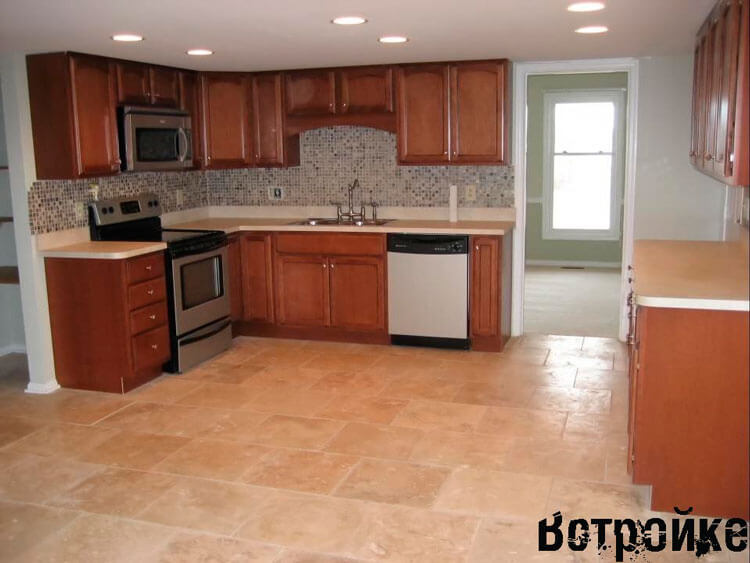
Kitchen floor design
Coating variants for kitchen
Given all the requirements outlined above, you can choose several options for flooring. The following materials are suitable for a kitchen with its characteristic features:
- tile;
- cork cover;
- natural wood;
- linoleum;
- self-leveling floors;
- carpet.
Now consider the main characteristics, advantages and disadvantages of each of these floor coverings.
Kitchen floor tile design
Tile on the kitchen floor is very common. Thanks to the many advantages of this coating, its popularity only grows. This material is quite solid and durable, it does not deform and is resistant to abrasion. The tiles on the kitchen floor are perfectly cleaned by any means, there is no trace of the impact of not only fat and soot, but also any household chemicals. The tile is extremely moisture resistant and does not absorb odors. In addition, it is environmentally friendly, does not emit any harmful or poisonous substances.
The range of tiles for the kitchen is very wide. Therefore, when buying a choice of the desired tile in color and shade will not be difficult. In addition to plain tiles, the buyer is given a wide choice of tiles with a pattern. Its texture is also diverse.
The disadvantages of floor tiles for the kitchen a bit. Do not drop the dishes on it. First, the dishes will definitely break. Secondly, tile is also a fairly fragile material, when it strikes it can simply split. Also it's quite cold floor. For fans to walk around the apartment barefoot, this coverage will be a lot of inconvenience. I'll have to make the floor under the tile.
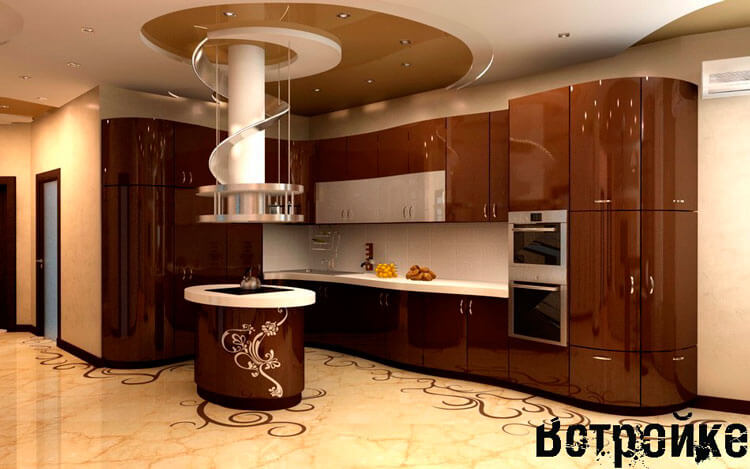
Kitchen floor tile design
Cork cover
This is one of the floor coverings, which, according to ecological purity and properties, is close to natural wood. In addition, the cork is rather soft and pleasant material, which brings comfort to the apartment and brings joy to the people living there. The only drawback of the plug is its ability to absorb moisture. However, modern technologies of laying such a floor can successfully deal with this disadvantage. Correctly laid flooring from the cork is not afraid of not only humidity, it does not leave stains from dirt and grease. Thus, the cork floors can be used in the kitchen. This coating, which has a beautiful natural color in yellow-brown tones and warm to the touch, perfectly fits into a quiet interior without a lot of scenery and bright colors.
Natural wood
Wood is a traditional floor covering, which has been used in residential areas for a long time. The natural tree is perfectly combined with the wooden elements of the kitchen. It is suitable for the design of the "classical" cuisine, and for the style of "country" is simply irreplaceable. It should be noted such advantages of the wooden floor as strength, durability, ecological purity and decorativeness. There are certain drawbacks here. Wood should not be strongly exposed to water and contamination. Usually, wooden floors in the kitchen are made only in the dining area, so that the wood is less deformed from moisture and temperature changes. However, different tree species react differently to these external factors. You can pick up such wood, which practically will not swell and dry up from moisture, but such floors will have a significant cost.
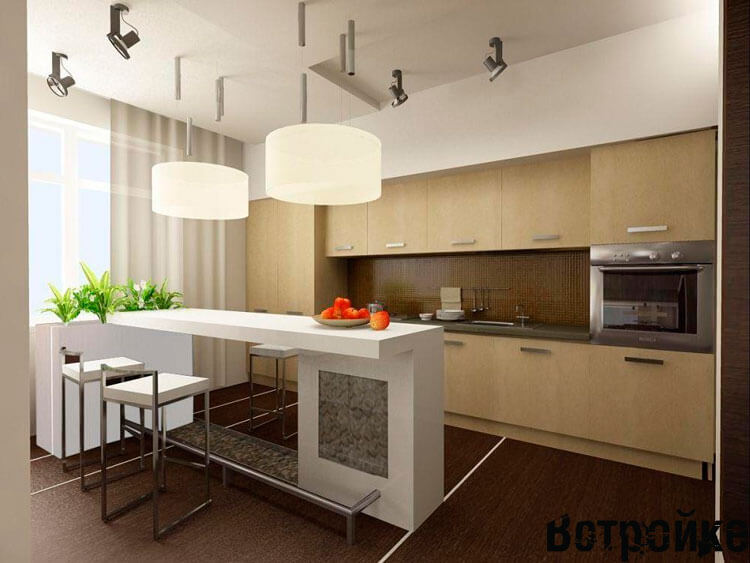
Linoleum
Linoleum today is the most budgetary floor covering, which is readily used in the kitchen. It is suitable for the kitchen in all respects:
- moisture resistance;
- strength;
- durability;
- convenience in care and maintenance.
On sale there is not only a plain linoleum, as in the Soviet years, but also with various beautiful drawings. You can choose a linoleum, the color of which imitates natural wood, parquet or stone. To the floor in the kitchen was not cold, you need to choose a linoleum with a substrate of natural materials.
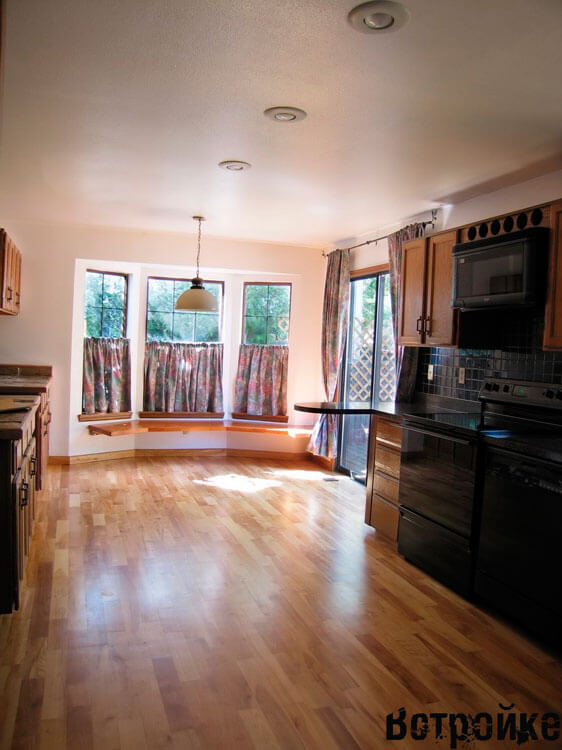
Self-leveling floors
Such a coating occurs in kitchens is still very rare. Although the characteristics of the filler floor are quite suitable for the kitchen with all its features. The main advantages of coating this type are strength and durability. Properly equipped bulk floor does not require repair and alteration for many years. Also its excellent quality is the ease of operation. Washing such a floor is not difficult, which will help maintain the necessary cleanliness in the room where food is prepared. On the decorative coating should be said specifically. Modern floor can be made of any color and shade, and even with a three-dimensional image. Of course, liquid 3d floors will be appropriate not for every interior.
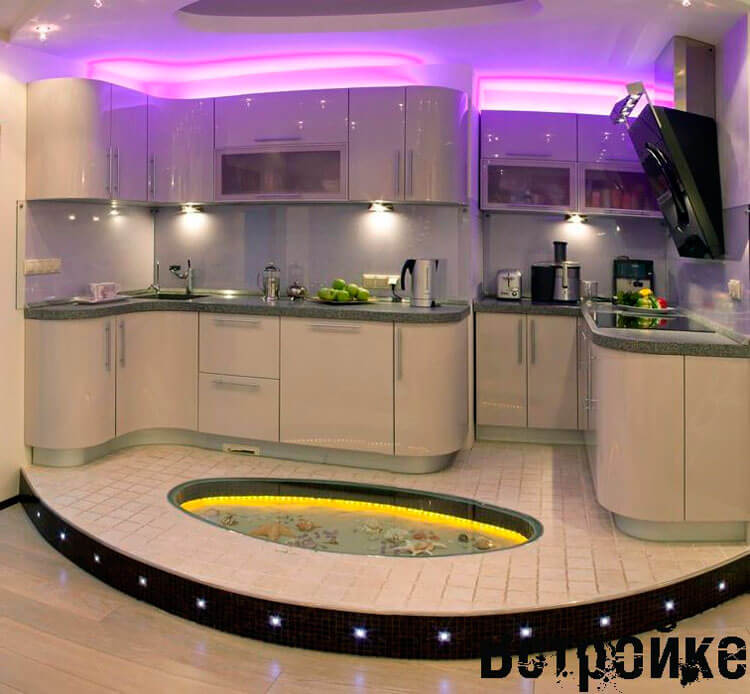
Carpet cover
Laying carpet in the kitchen - a bold and non-standard solution. To many it will seem irrational, as carpet in the kitchen will be heavily polluted. However, it should be noted that in the sale there are many tools with which it can be effectively cleaned and washed. And vacuuming the carpet is not difficult, such cleaning will not take much time. For other parameters this material is quite suitable for a kitchen. Synthetic carpet is not spoiled by moisture, the temperature change does not affect its properties, it is a soft and non-slip coating, which is nice to walk barefoot. Therefore, we can say with confidence that its popularity as a floor covering for the kitchen will grow.
Design techniques of arrangement of kitchen floors
None of the flooring for the kitchen is ideal. However, they can be successfully combined. Today, in spacious modern kitchens, it is not necessary to lay a floor covering of one type. You can create an interior with a division of the room into functional areas, and a variety of types of floor coverings will help in this. Usually in the kitchen area are allocated 2 zones: for cooking and dining area. For the first apply moisture resistant coatings that are easy to clean, for example, tiles. For the dining area suitable natural wood, cork or laminate. As practice shows, this division is the most rational.
Undoubtedly, we create an impression of the kitchen with a successful combination of colors and textures in it, like furniture, textiles or finishes. In addition, functional work surfaces and household appliances make the kitchen a dream the last.
And what about the flooring? After all, it carries a huge load and is constantly tested with detergents. Scales, scratches and even cracks are the incomplete list of the consequences of the wrong choice of floor covering, and if you had to do it hastily, rest assured, only a few years will pass and the desire to "reshape" the floor will become an obsession for you.
We intend to help with the choice of a reliable coating, so that this does not happen. Today we will talk about the use as a floor covering of materials familiar to us, as well as new ones, only gaining popularity.
How to choose a kitchen floor tile
The popularity of tiles has long been surprising, because the variety of colors and textures is impressive, and a wide range of prices can not but rejoice. However, being just one step away from making a purchase, few will pay due attention to the list of characteristics that determine the future life of such coverage.
Below we present this list, based on which, it becomes quite possible to purchase high-quality tiles at democratic prices.
Main Features:
- The amount of ceramic firing and glaze coating extends the service life
- Resistance to reactive substances determines the reaction of the material to the action of acid and alkali
- Hardness and thickness will serve as a barrier to impacts from sharp and heavy objects
- Resistance to abrasion due to movement of large objects
- Slip resistance indicates how safe the coating will be, especially for children

The tile is known for its ability to imitate various materials in color and composition, such as wood, marble and natural stone. Given the high performance of the above characteristics, in particular, aesthetic, it can be completely confused even with travertine - a porous stone. 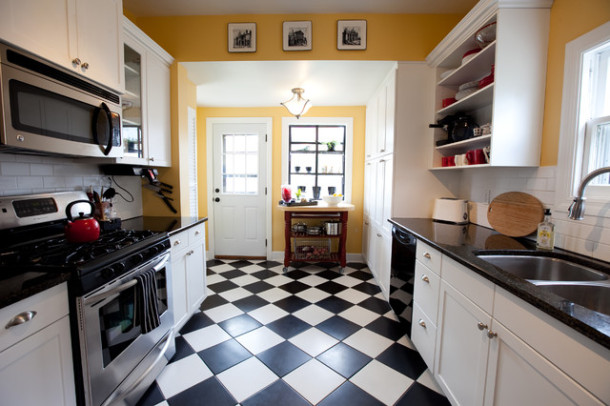
A nice feature of the tile and the main difference from the ceramic tile is the glaze coating, which makes the first more durable and qualitative. In addition, the laying of tiles, with the observance of certain recommendations - is not a laborious process.
Styling features:
On the prepared flat surface of the floor, with the help of a grater, a glue solution is applied, then, the tile after the tile is laid out the desired pattern or alternating large and small fragments. You may need a tile cutter to fit the necessary pieces, as well as a tape measure and a building level. The final stage is the application of the trowelling compound for the intertitic joints. 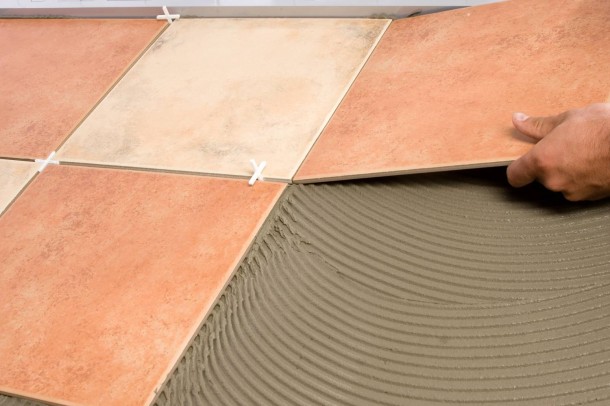
How to choose a floor for the kitchen floor
A common and very interesting option for finishing floors is piece parquet. From his brother - parquet from solid wood it differs only in size and is a kind of inexpensive analogue. Traditionally it is made of beech, maple, oak, but exotic analogues are possible: wenge, iron tree and merbau. 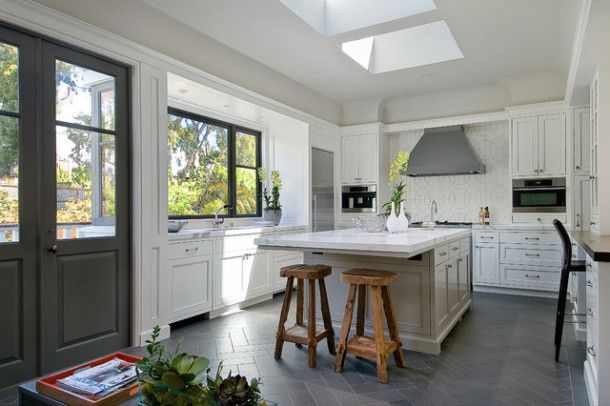
Piece parquet enjoys well-deserved respect among connoisseurs of the most important characteristics of flooring in kitchens. Its properties amaze and justify the cost of this material. 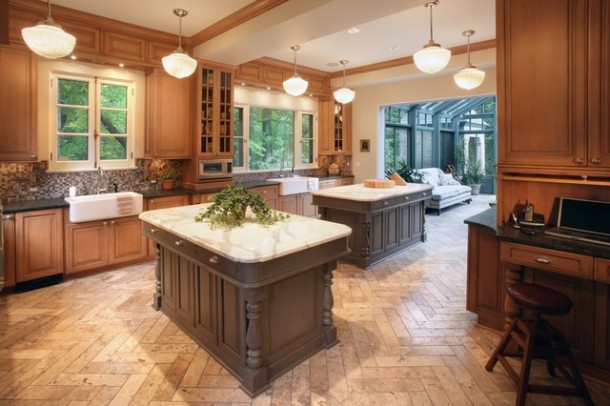
Main characteristics:
- Longevity as the main feature of this type of parquet became a visiting card
- Minimum slip or total absence
- Clear ecology and static
- Variety of laying: from simple to artistic
- High strength
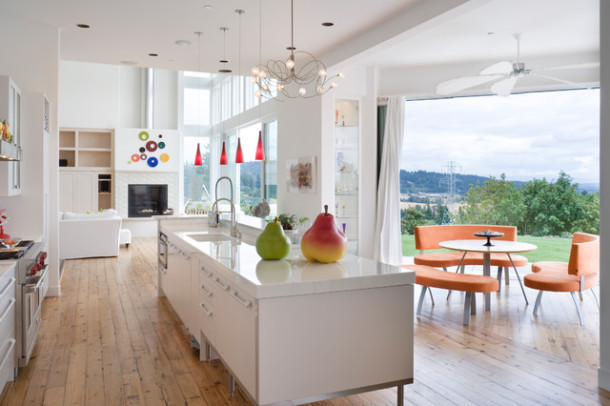
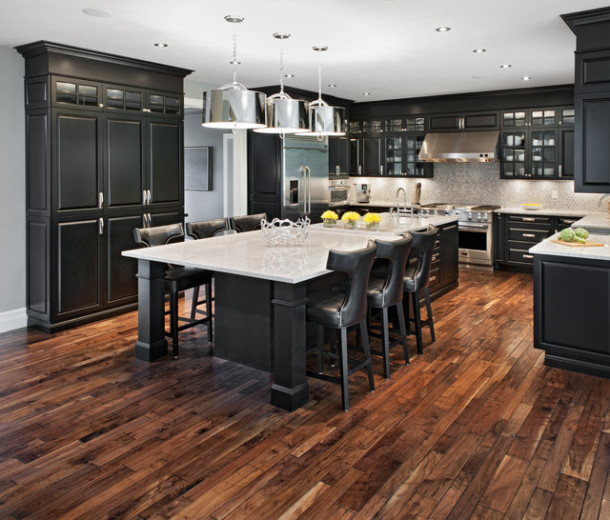
If you decide to independently lay a piece of parquet in the kitchen, be consistent in the following steps.
Styling features:
First of all, the surface cleaned from the old coating should be leveled with a cement screed or with a self-leveling mass, depending on the size of the irregularities. This step is very responsible - the evener, the better the parquet will lie. 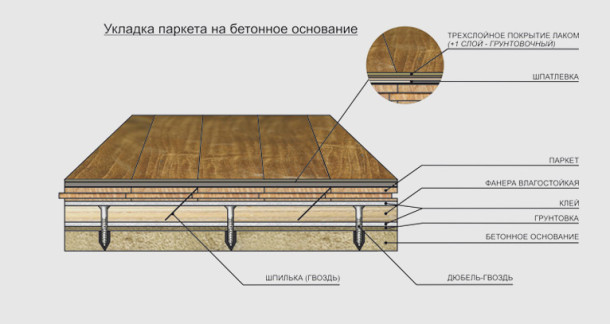
When using a cement screed, you should wait until it dries well, otherwise the consequences will be irreversible, and the result is unsatisfactory.
After the screed has dried, it is glued to the sheets of plywood, previously cut into four parts. Then begins the installation of parquet boards. The duration of this phase depends on the size of the surface and the type of pattern.
The next stage is grinding, but not earlier than two or three days after laying. After this, proceed to filling the gaps between the slats and polish the parquet again.
The completion of such a long process should be a primer before applying a minimum of three layers of varnish. After it dries, the floor is ready.
Marmolium in the kitchen
Marmoleum is an environmentally friendly material for flooring, which is an improved linoleum. The raw material for the production is jute, vegetable resins and cork, as well as impurities of linseed oil and wood flour.
In addition, the huge advantage of Marmoleum was its unimaginable number of colors and shades obtained from natural dyes. Therefore, designers use it to implement the most daring solutions. 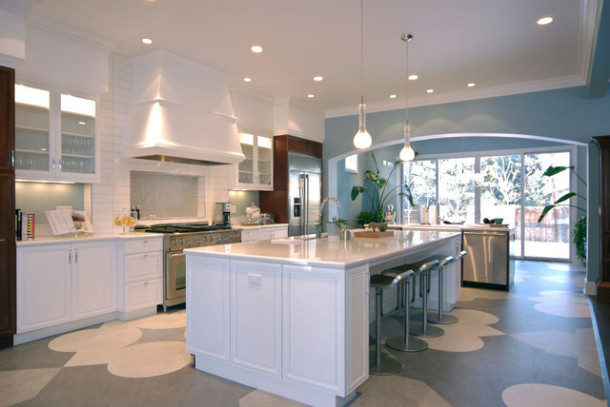
Can I apply Marmoleum in the kitchen? Undoubtedly, and moreover, we advise you to get rid of outdated coatings, like linoleum, in favor of a new coating with obvious advantages.
So, the main characteristics:
- Has antimicrobial properties, thanks to natural ingredients. Therefore, it can be used in any, even children's rooms
- Resistant to damage, which means that the coating does not leave any dent in the linoleum
- The material is resistant to cleaning by any detergent
- A special technique for drawing a picture protects the coating from sunburn
- The laying process will not be difficult

A huge variety of colors of Marmoleum allows you to arrange colors at your discretion. For example, bright yellow stripes look impressive against the background of dark graphite slabs. You can also apply two and three shades in the design of the floors 
For those who choose marmoleum in their kitchen, the way of laying this coating will remind of the tile, because it is delivered in the form of small fragments, and not in rolls, like linoleum. Tiles of Marmoleum are simply glued to the flat surface of the floor.
Laminate in the kitchen
Due to its durability, laminate is also used in high traffic areas (offices, shops), and in apartments and houses. With excellent characteristics this modern floor covering has earned respect among consumers, architects and designers.
The material is able to imitate parquet, tile, cork. Therefore, to date, it remains the most popular in the design of the floor. 
Laminate can be very similar to parquet, because it has a characteristic pattern, but to create with its help the imitation of the natural floor in the kitchen is much easier due to lower prices. 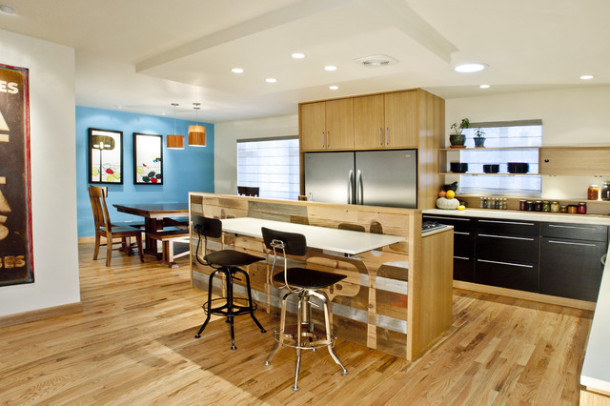
Laminate always consists of such layers:
- Top layer - film with special resins
- Decorative layer with printed pattern (paper impregnated with resins)
- The third layer is a high density wood board
- Lower stabilizing layer
The use of laminate in the kitchen is quite appropriate. If, being far-sighted, choose a variant of a wood plate with a high moisture absorption coefficient, you will certainly be satisfied with the acquisition.
Main characteristics:
- Environmentally safe
- High strength, durable
- Resistant to aggressive environments
- Does not burn
- Resists dents and scratches
- Suitable for cleaning with detergents
 1
1
Styling features:
Speaking about laying laminate, it should be noted that the thicker it is (8-12 mm), the easier it is to assemble it. Distinguish prefabricated and adhesive ways of fastening plates. With the assembly, special locks are snapped, connecting the plates to each other. This variant is full of advantages, because it, if necessary, is just as easy to disassemble, which can not be said about the adhesive method, when the plates are glued together, and are no longer disassembled. 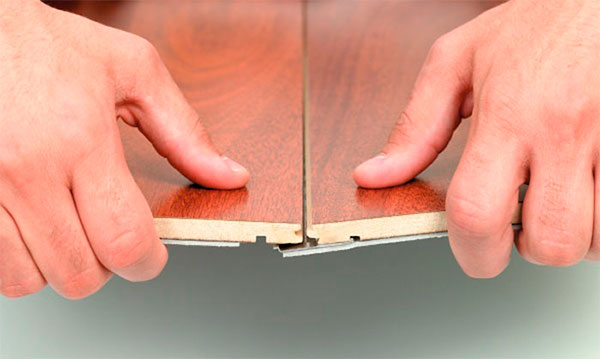
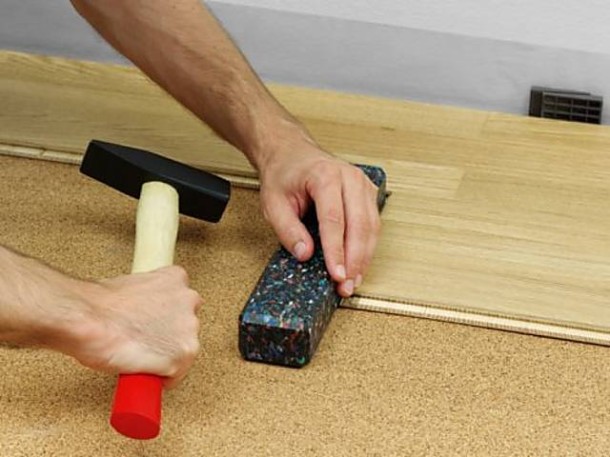
How to designate a kitchen with a floor
Often the kitchen from one independent room turns into a kind of space adjacent to the dining room, living room or corridor. However, we are nevertheless inclined to separate the working area of cooking from the place of its use. And in the absence of partitions, this can be done with the help of flooring.
1. Different types of flooring
Unpleasant, and sometimes difficult to remove stains from cooking fatty foods constantly fall on the floor near the stove. In addition, the area around the working surfaces suffers from drops of sharp objects and dishes. It is possible to make the working area comfortable and safe by placing a particularly strong and well-washable coating, such as tile or marmoleum. The rest of the floor is covered with more decorative material, for example, parquet. 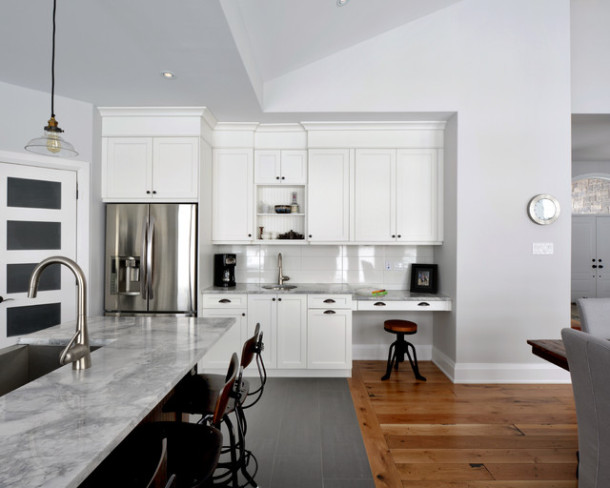 1
1
2. Zoning with color
The floor in the cooking area can be made not only practical, but also at the same time to highlight it with a color in it. The floor of a lemon color in a combination to green table-tops and turquoise of walls - such variant of registration looks especially advantageously.  3
3
3. Separation of the kitchen area with a partition
Dividing the floor into zones using tiles in the kitchen, and laminate flooring - in the living room, you can add a pseudosten: the partition between the rooms, which is adjacent to the hob and extract from the kitchen area.  1
1
A beautiful decorative effect creates an intricate curly tile in the kitchen, clearly, without excess, separating it from the living room. A nice shade of light wood in the facades of furniture is well combined with laminate in the reception area. 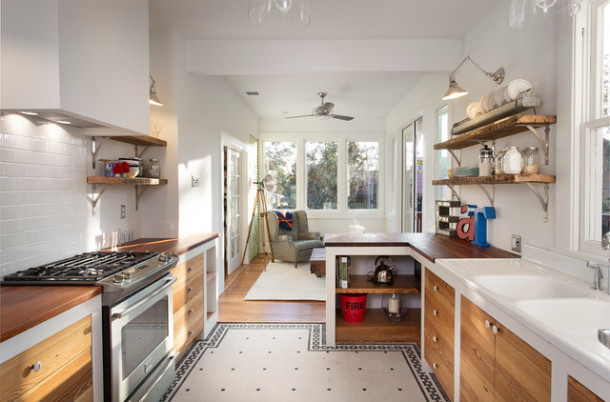 1
1
The floor covering should meet both the aesthetic requirements and the operational characteristics of the room. A wide range of floor coverings makes it possible to choose what to lay on the floor in the kitchen, based on the individual preferences of the owner.
Types of flooring
Completely avoid the case of falling on the kitchen floor fat, juice is impossible. Therefore, the floor covering should have a dense structure or a good protective layer, repellent dirt. A high indicator of resistance to moisture aggression, detergents of home chemistry will ensure the integrity of the coating, the safety of external attractiveness.
- Tree. Natural wood will decorate any room. But in the hard operating kitchen conditions, regular - 1-2 times a year, updating its protective layer will be required.
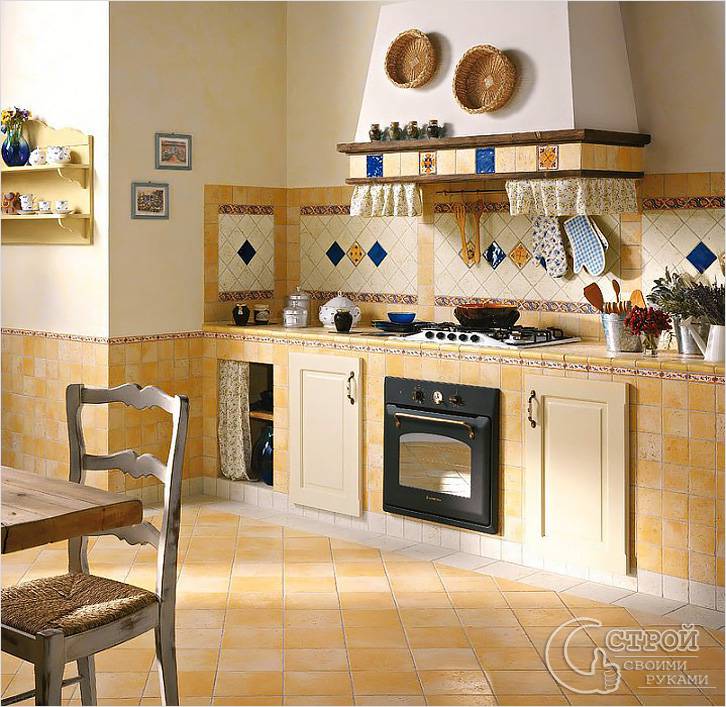
- Ceramics. Ideal resistance. It is ceramic tiles used for finishing kitchens catering enterprises. On such a floor, you can safely put a hot brazier. The minus is the "coldness", "rigidity" of the coating. The installation of the "warm floor" system helps to smooth out these disadvantages.
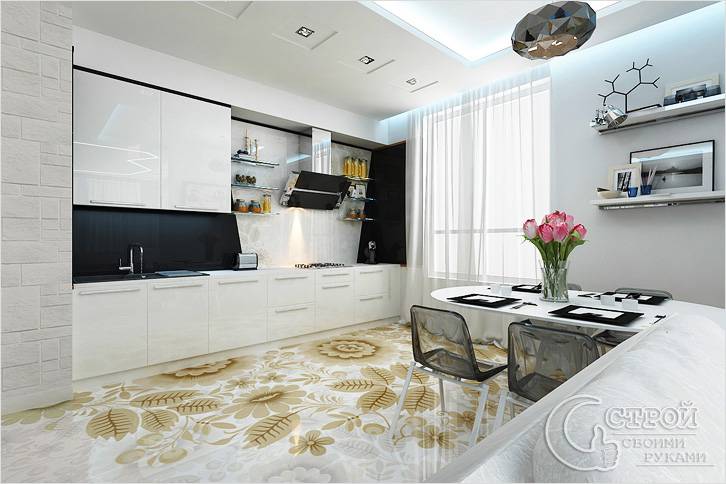
- Underground floor. Thanks to the active use of polymers, he has a beautiful appearance. Its smooth, seamless surface is not afraid of moisture, does not absorb fat, easily tolerates sanitary treatments with detergent and disinfectant solutions. As in the case of ceramics, the "warm floor" system is used to increase the comfort level. Minus is a difficult disassembly if replacement is necessary.
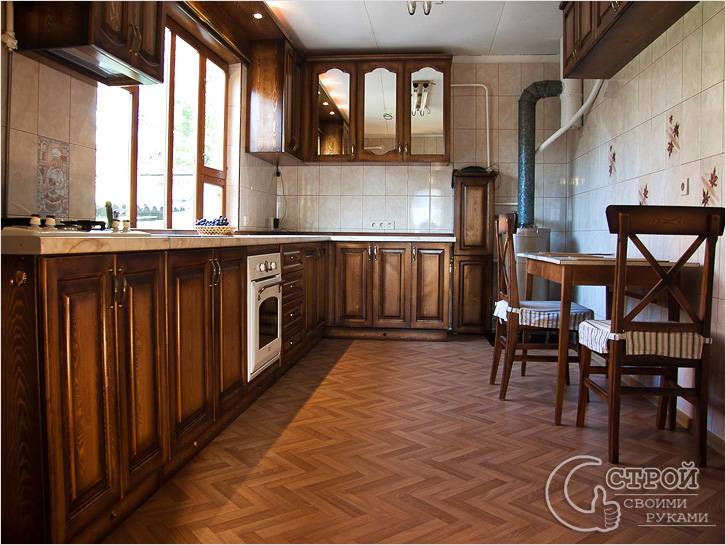
- Linoleum. Beautiful, practical, hygienic. The protective layer of quality material will not damage the spilled soup. Provided good insulation on it you can walk barefoot even in winter. A hot pan can damage the top layer.
- Carpet cover. This material is not recommended to be laid on the floor in the kitchen.
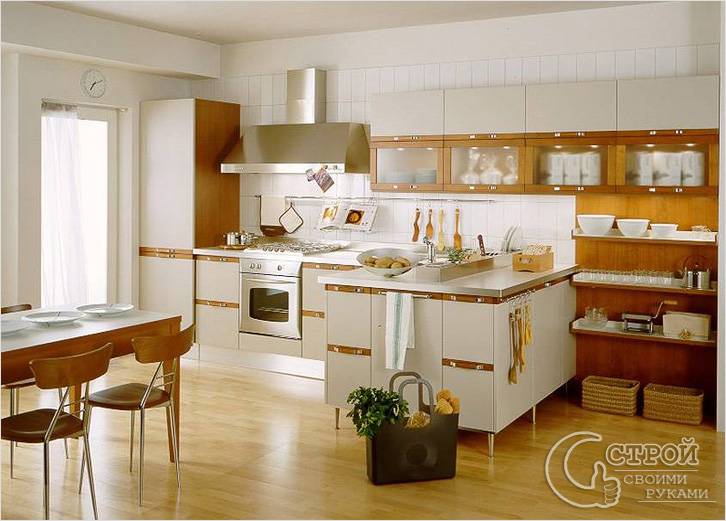
- Laminate. Despite the statements of producers about the high quality of their product, it should be borne in mind that, in fact, laminate is an ordinary paper. Strict adherence to the technology of surface preparation, professional installation and careful handling are the conditions for using the material in the operating conditions of the kitchen.
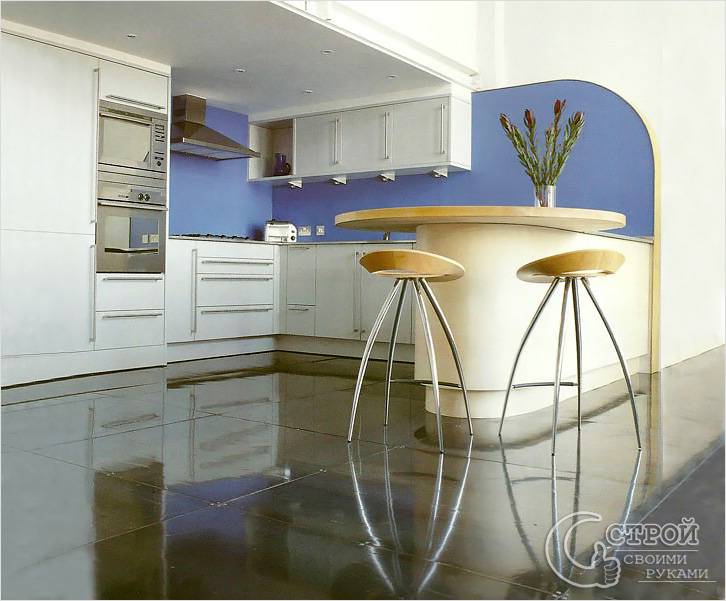

Choose what to lay on the floor in the kitchen, it is quite difficult - stone, wood, cork, composite materials.
Note! One of the solutions to the problem of finishing the floor in the kitchen can be the separation of the room into zones.
The working area, which is more prone to aggressive effects of moisture, hot objects can be equipped with strong materials - ceramics, liquid floor. The rest space can be finished with cork, laminate, linoleum, etc. In this case, when repairing or replacing the cover, it will be possible to do without dismantling household appliances and furniture.
Additional Items
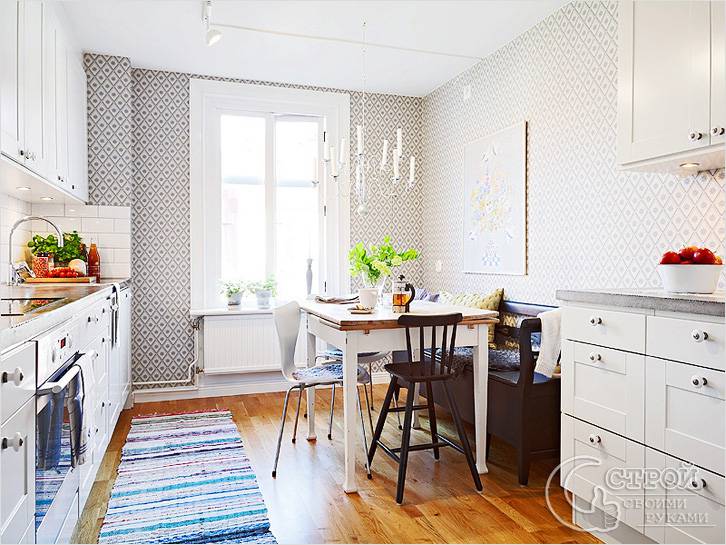
Sometimes, to give more comfort and coziness to the kitchen, a mat rises on its floor.
It can be made of almost any material - vegetable, synthetic fiber. Mats are very popular. But the most practical are mats made of nylon, polypropylene, wool.
Note! It is better to choose small rugs that are suitable for machine washing.
Also, when choosing, pay attention to:
- product density;
- the presence of a non-slip lining;
- resistance of the material to hot objects.
Rugs can be placed in the working area, at the dining table. They not only decorate the kitchen, but also protect the floor covering from mechanical damage.
It is better to buy a few pieces for a change.
Video
For more information on floor coverings, see the following video:
A photo
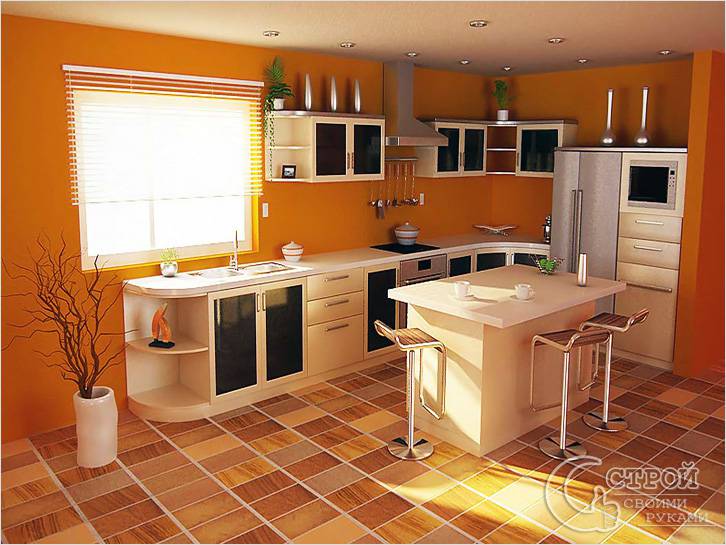
One of the important stages of kitchen repair is the restoration of the flooring. It should not be afraid of fat, moisture, or any mechanical effects.
Repair of floors in the kitchen is a responsible, difficult matter, requiring proper and careful selection of materials, as well as compliance with technology work. Carrying out repairs, you need to consider the important factors that will affect the characteristics, quality of the floor and life. Among them is the following:
- constant temperature changes and increased humidity. During cooking, there are unfavorable conditions for floor covering: splashes of grease and water, detergents for appliances and dishes, steam from food, sudden temperature changes - this is able to withstand not every material;
- contamination with oils, grease and the like implies the use of aggressive chemicals for cleaning, so the floor covering must be stable and strong;
- high loads on the floor. Usually in the kitchen we spend a lot of free time, so the floor covering is regularly subjected to intense mechanical stress and can wear out.
In our time for modern kitchens, several types of repair are used, and each of them is distinguished by certain stages of work:
- cosmetic repair of the kitchen includes the dismantling of the previous floor covering, sealing of irregularities, cracks; Shpaklyutsya all minor defects, changing skirting boards. This repair is often resorted to, since it does not require much time and dismantling of equipment. The owner simply enough to take out furniture from the kitchen and remove the old floor covering, which he is going to replace;
- overhaul. It is used, as a rule, when there is a need for redevelopment and when making changes in the system of heating, gas and water supply. Most often at this time, work is carried out on the leveling of the floor, installation of basic systems, or additional heating called "warm floor". Naturally, this kind of repair of floors in the kitchen is more extensive and involves a lot of time and money;
- european-quality repair - a harmonious and full complex of works, including finishing, design and design ways of changing the interior. Moreover, not only the leveling of the base is carried out, but also the design of the floor, the communications are often made, the so-called rough floor, etc. is installed.
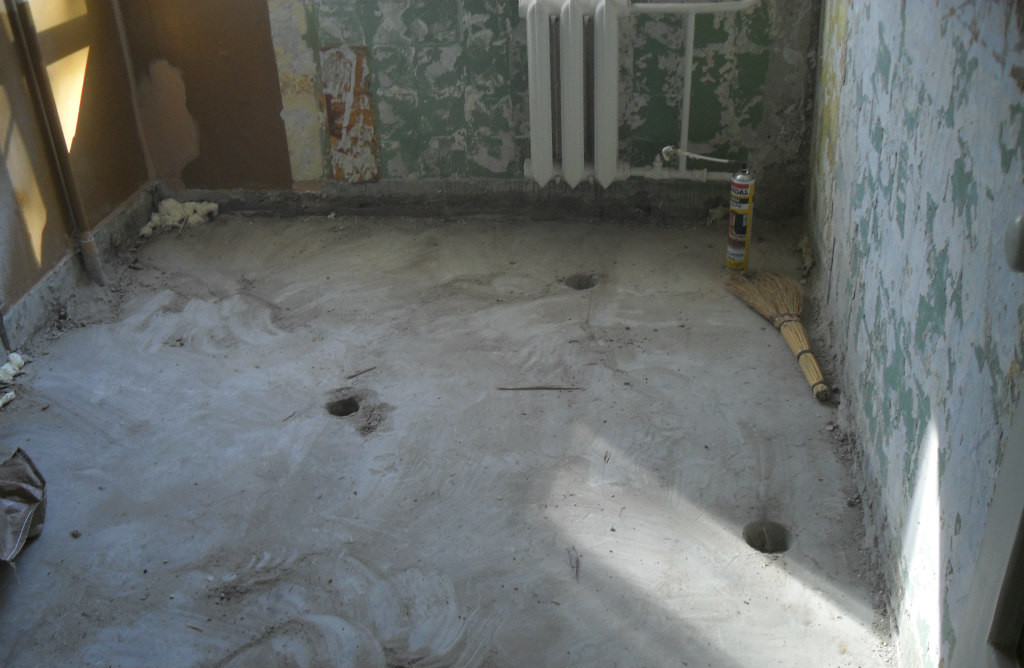
Repair of floors in the kitchen with your own hands: choice of floor coverings
To ensure that the floor in the kitchen meets all the requirements, you have to invest in its repair, not only efforts and means, but also your imagination.
Floor finishes and kitchen repair options are quite diverse. The floor covering can be classified according to the following characteristics:
- materials used;
- the form;
- surface color.
Often the form of the floor remains flat, but when you combine the kitchen with the living room, a multi-level floor is often created, which allows zoning.
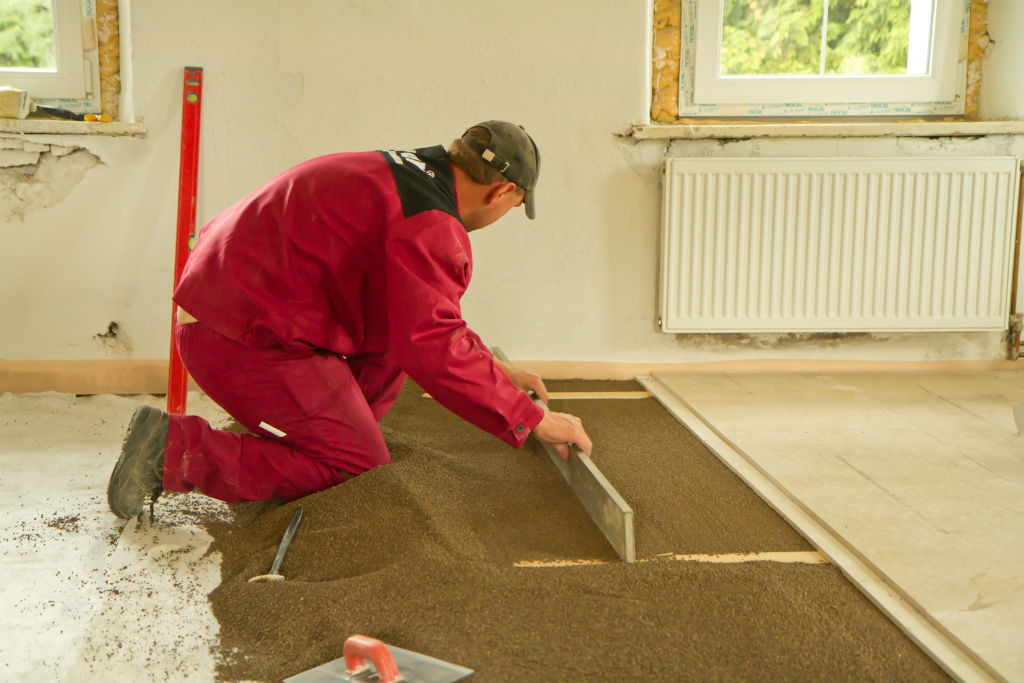
Basically for floor covering use:
- laminate;
- linoleum;
- porcelain tiles;
- ceramic tiles;
- liquid linoleum.
As for the color of the surface, it can be monophonic, with a single texture or pattern on each unit of coverage, as well as with a general pattern that is collected from a set of mounting units.
Let's consider in more detail what each of these options represents, and what features the process of their installation has.
Floor shape in the kitchen
A multi-level floor is often provided for by the created design project. This floor can only be done in a spacious kitchen, where you need to separate the workspace from the location of the dining table.
Even at the stage of casting screed he is given a form. As a rule, such actions take place within the framework of major repairs.
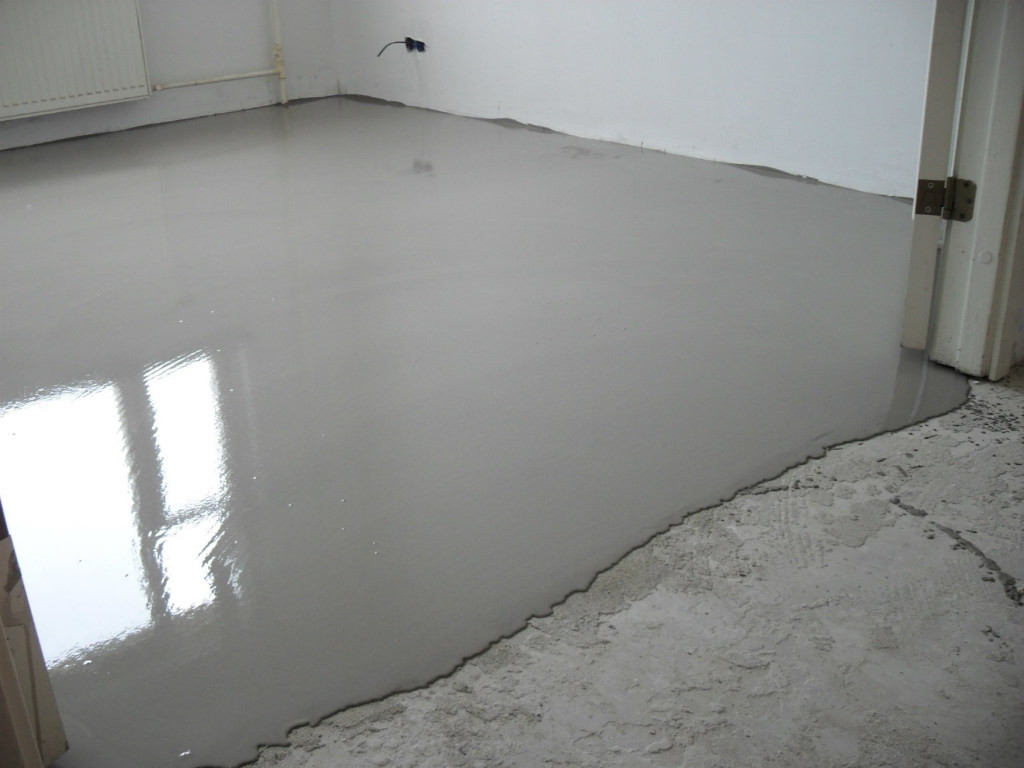
If you are planning to perform a classic floor surface, then a simple flat screed is poured, after the drying, the facing is mounted. Installation of a multi-level floor also begins with a simple screed, and after it is completely dry, you need to set the limiters that give the desired shape of the step, and fill another layer of concrete in the formwork.
Important! To make it easier to achieve an even surface during the arrangement of the screed, we recommend using self-leveling mixtures.
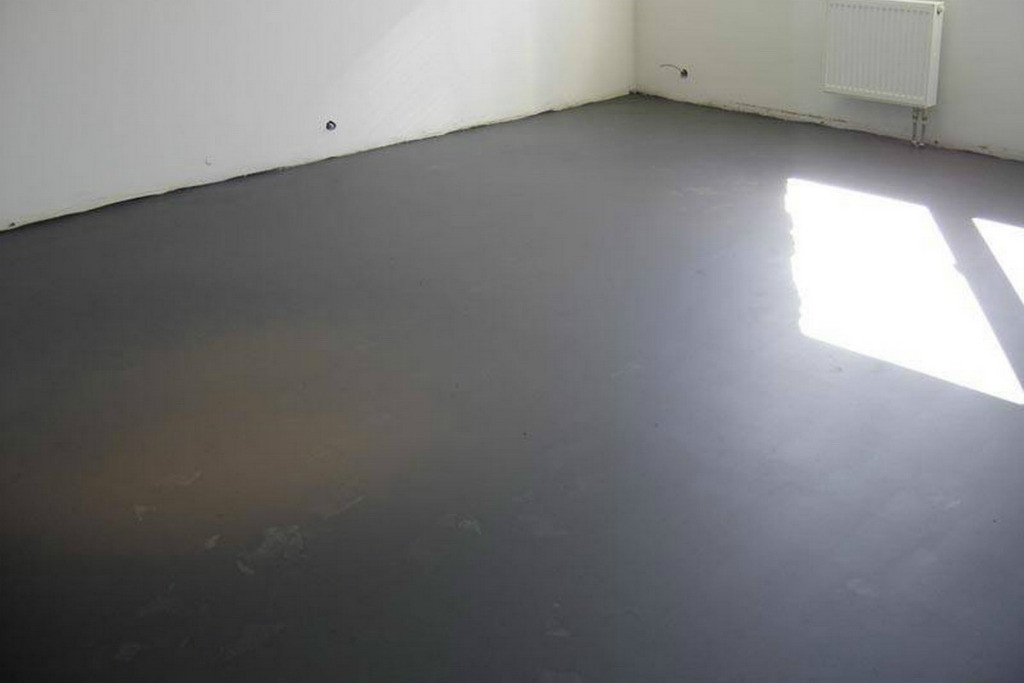
Repair of floors in the kitchen with their own hands: photo, coating materials and their installation
- Linoleum for the kitchen.
Linoleum - attractive in cost and practical material, which will be an ideal option if you need to perform inexpensive kitchen repairs.
Compared with dull color schemes, linoleum has a richer color spectrum, which is represented by an interesting and wide variety of textures, patterns and colors.
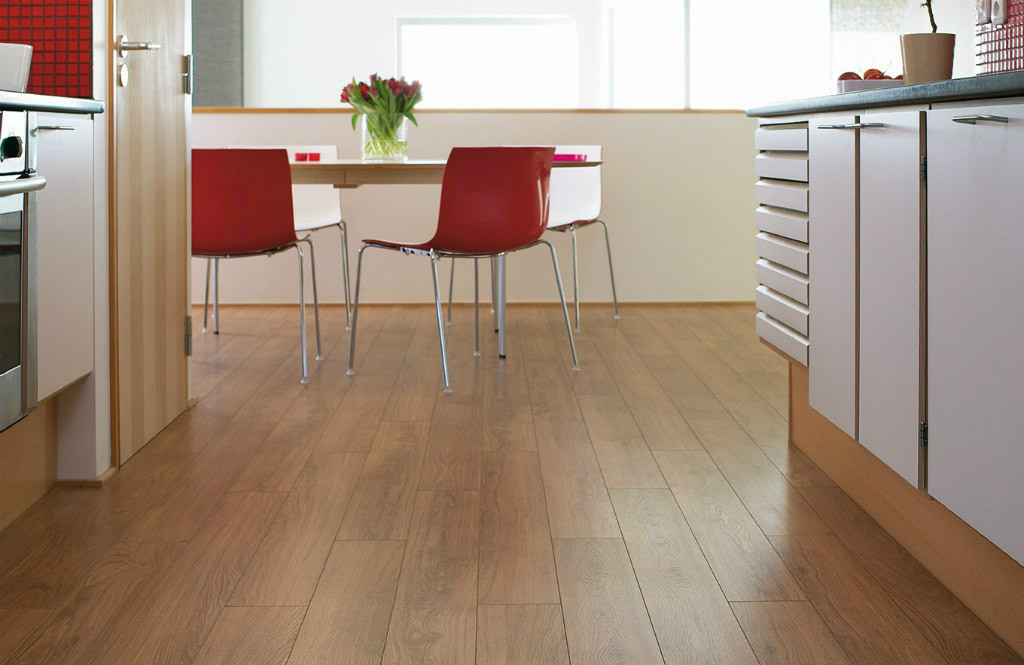
Linoleum itself can last about 10 years and has excellent sound and heat insulating qualities, as well as high wear resistance. It is convenient and easy to wash, which is a huge plus.
It is impossible not to note the simplicity of laying linoleum. First it is necessary to spread it on the surface and wait for it to lie for at least 24 hours. Next is to give it the necessary shape, cutting out the corners, cutting off excess parts with a construction knife and a metal ruler.
Throwing the edges of the linoleum alternately, put a layer of special glue on the base with a spatula, then apply the lining material.
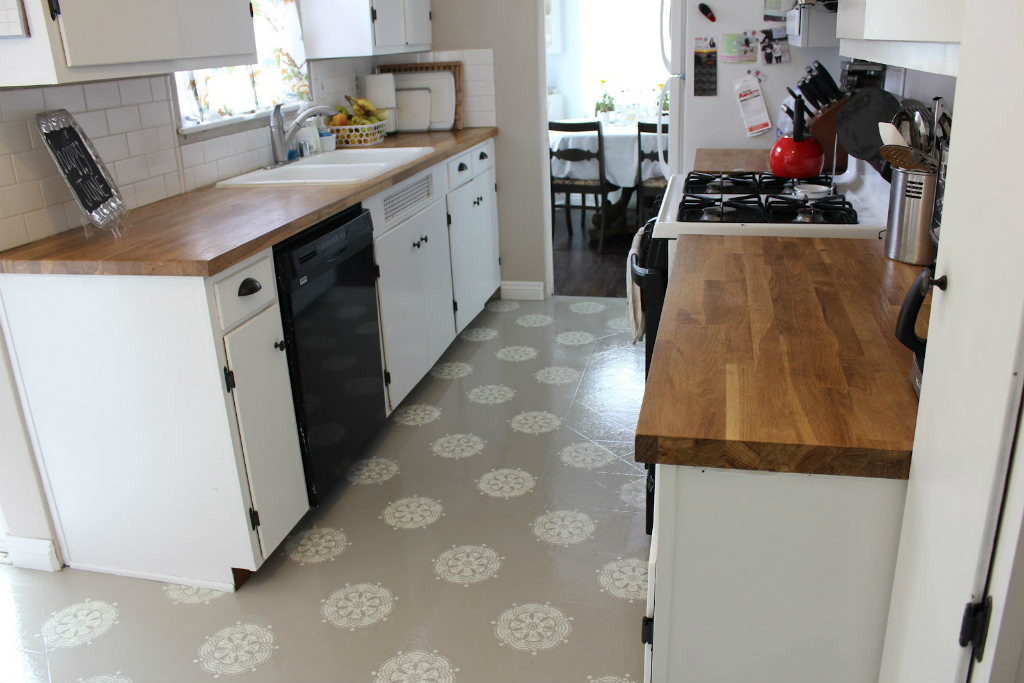
If it is necessary to join two pieces of material, overlap each other and make a straight cut with a knife. This results in an ideal joint, and then it is smeared with joinery glue to make the coating impenetrable and intact. It remains only to adapt the plinth.
- PVC-tiles.
PVC-tiles - this is nothing like a linoleum, which is cut by strips or squares. PVC can simulate a stone or glossy tile, laminate or parquet. Usually, PVC-tiles are equipped with an adhesive side, which means that when laying it is enough to remove the protective layer and simply glue it to the floor. The process itself is elementary. The foundation has no preparation. If one of the tiles is damaged, it can easily be changed to a new one. This coating has the same drawbacks and pluses as linoleum.
To the advantages of tiles can be attributed a convenient application in the combination of different floor coverings. In some kitchens, thanks to the size, it's easier to paste tiles than linoleum. However, PVC tiles also have disadvantages. The weakness of such floors is the joints of PVC tiles. If they get there, they can get unstuck, and the floors lose their original appearance. In order to exclude this, it is necessary to pass joints of tiles with special compositions, after which they will cease to be afraid of moisture.
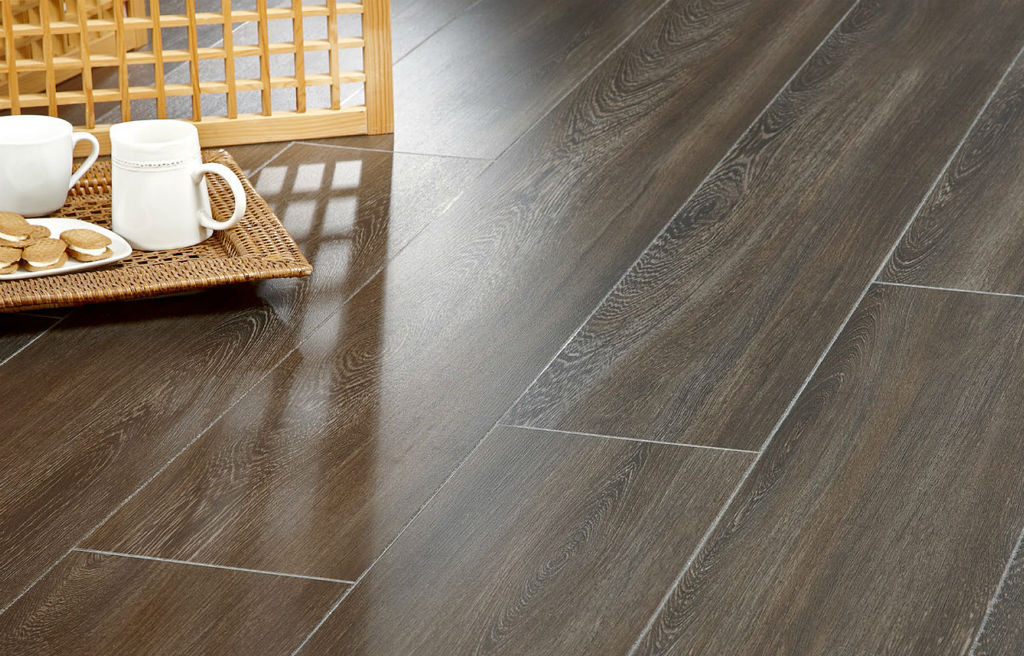
- Laminate for the kitchen.
Laminate is a worthy alternative to an impractical wooden floor, as it is more resistant to scratches. It perfectly imitates the wood species (including exotic ones), marble, tile and granite.

The cost of repairing the kitchen when using the laminate does not become critical, since with all operational and external advantages the material is relatively inexpensive.
Performing floor repairs in the kitchen with their own hands, experts recommend using a laminate, characterized by increased water-repellent properties, it does not like prolonged contact with water.
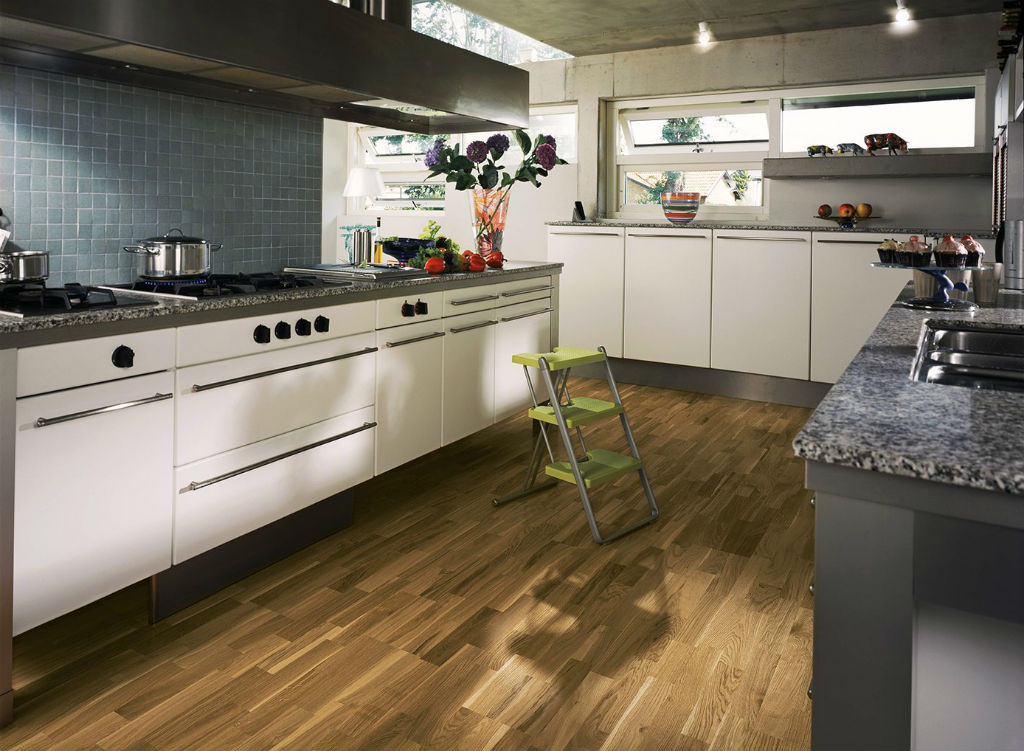
Laying the laminate is done on an ideally firm, even, clean and dry surface. If it is laid on concrete, then for safety of vapor barrier it is necessary to lay polyethylene film.
Before laying, wait for the material to "acclimatize", putting it in the room for 2 days. Lay the laminate so that the seams between the slabs have a parallel arrangement to the window light, because they will not be so noticeable. The modern material is equipped with special connecting locks, which does not imply the use of an additional fastening either by self-tapping screws or glue.
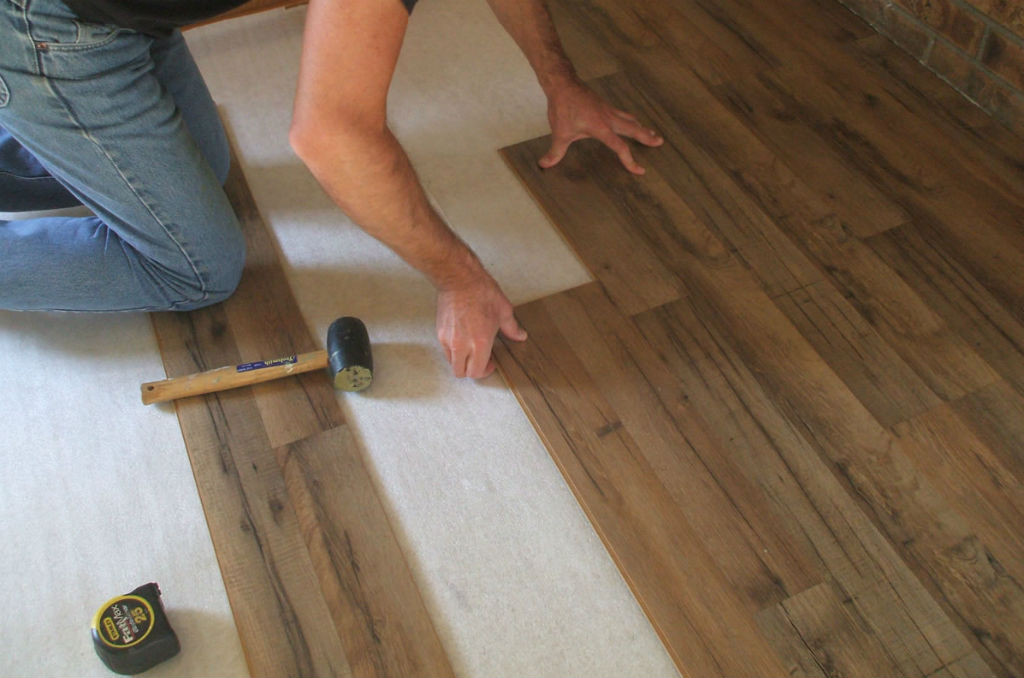
When laying, make an indentation from the walls around 10-15 mm, as the laminate is able to expand under changing temperature conditions.
The slabs are laid in longitudinal rows: from either side wall, gently snapping each next plate into the lock of the previous one, the edges are hidden under the skirting boards.
- Ceramic tile.
Probably one of the most popular coatings that are used, making repairs in the kitchen with their own hands. For floor use special floor tiles, which can mimic different natural materials

Installation is carried out directly on the dried screed. With a spatula with toothed edges, a layer of tile adhesive is applied to the floor and then a tile is applied to it. The process of laying is accompanied by level control - you need to tap the tile with a hammer that has a rubber boot.

With regard to the thickness of the seam between the tiles, it should not be more than 4 mm and is regulated by special crosses. The seams are treated according to the color of the tiles with a special trowel.
- The cork floor of the kitchen.
Nowadays cork flooring for the kitchen is far from being new. But anyway, this material is not so widespread yet. This probably explains its high cost and the fact that such material does not inspire confidence. Cork cover is perfect for the kitchen. The cork is warm, pleasant to the touch, soft and has excellent noise insulation. Plus, this material is environmentally friendly, like the actual wooden coating itself.
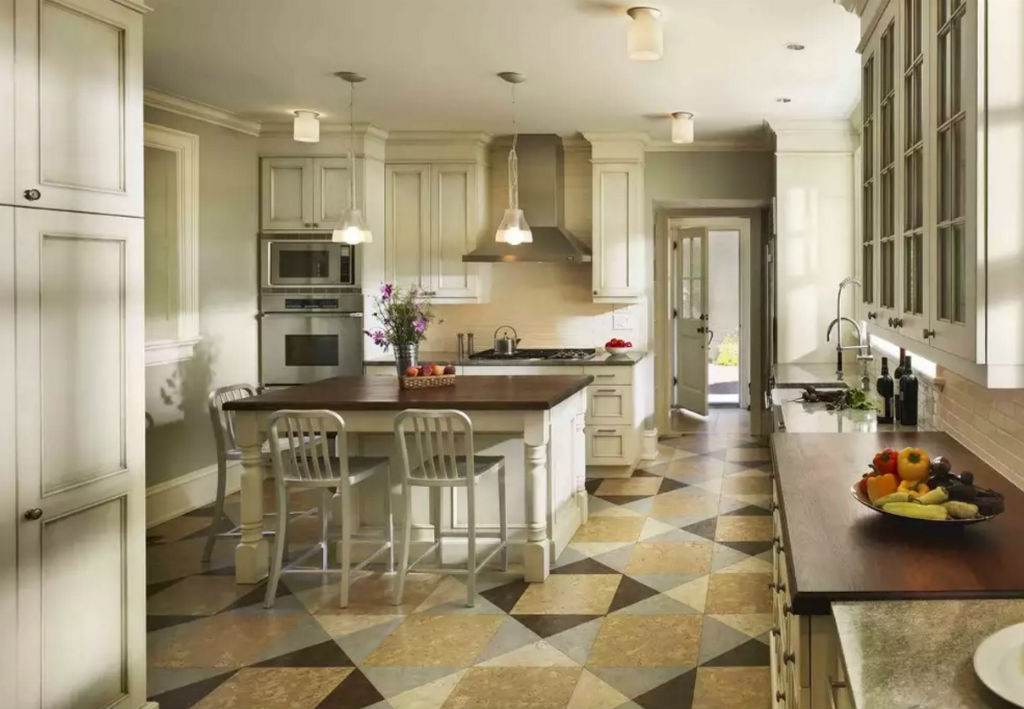
Cork is not afraid of moisture, does not rot and does not swell. With a stopper, you can clean any contamination. On such floors there is no accumulation of dust, because they have antistatic properties. But how will the coating react to the falling of a hot and heavy object? The blow, of course, will leave a mark, but the unique texture of the cork will hide the traces.
On a cork for imitation of a valuable tree put different types of textures. They allow cork coatings to look like expensive parquet.
In the work area where food is cooked, falling sharp objects, hot fat splashes and high humidity, floor cork, just like parquet, can be damaged, despite the advertising of manufacturing companies. Cork kitchen floors should have a special lacquer or wax coating, which give the material more reliable protection. But after processing the cork gets rough and will not be so pleasant to the touch. The best option - adhesive cork, consisting of 100% of the cork. Alternative cork material, having a basis of MDF, is not so practical and durable in the kitchen.
Other floor coverings
Before doing floor repairs in the kitchen, we recommend considering the option of combining different types of flooring. This technique is often used when covering a multi-level floor, for example, the dining area - laminate, and the working area - tiles.

Combining the floor covering is a creative process, which is far from being possible for everyone. For combination, you can decide on the optimal floor covering of one shade or choose a combination of contrasting colors. Carefully consider the choice of materials for the combination of the kitchen, which is combined with the living room or dining room.
After all the installation work is completed, you can easily invite your friends to inspect the renovated kitchen.
Choosing a skirting board
Repairing the floor in the kitchen with your own hands means protecting the joints between the surface of the walls and the floor. For this, a plinth is used, which is able to acquire a variety of shapes.
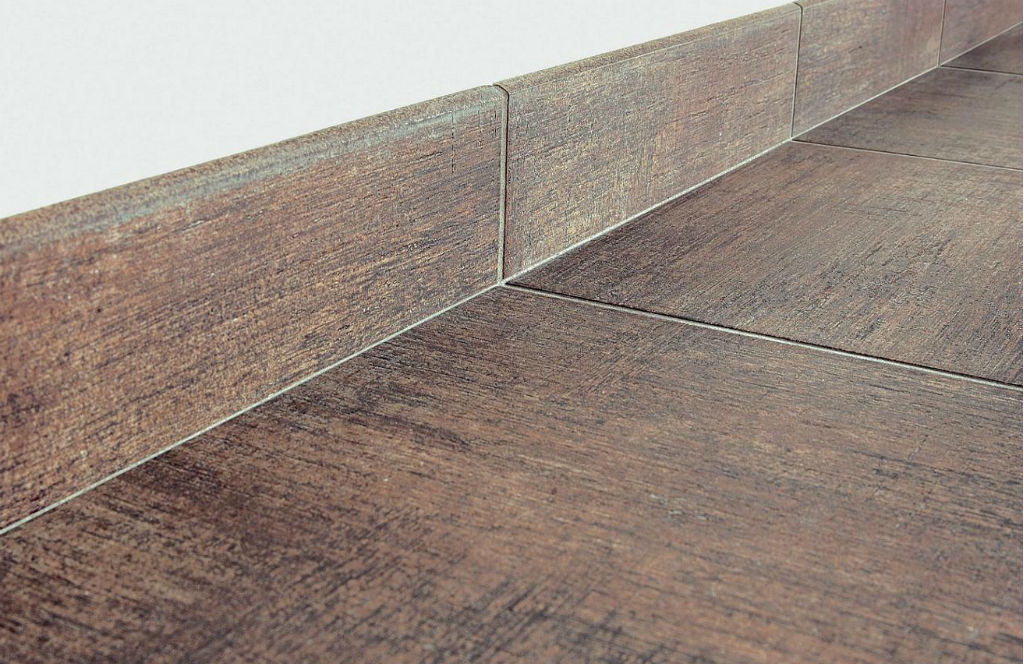
The skirting boards themselves can consist of PVC or be made of wood. The latter should be installed only for flooring from natural wood (solid board, parquet). However, the plinth requires lacquer coating or staining to ensure effective protection against moisture. Experts advise to use simple PVC skirting, harmoniously combined with the color of the floor.
To summarize, it is worth noting to choose the type of kitchen repair and material, you need to analyze all the factors of operation. How accurately and often you cook, how much you like to clean in the kitchen, how many people are in the apartment, etc. According to experts, the priority in standard kitchens is linoleum and tiled floors.
